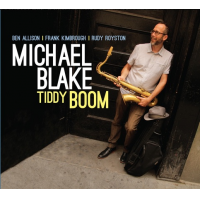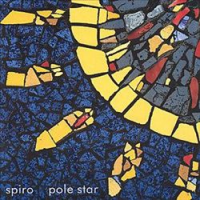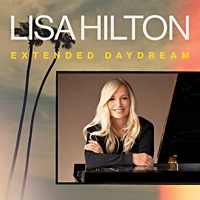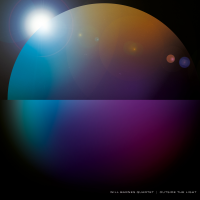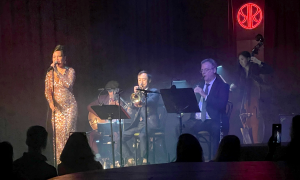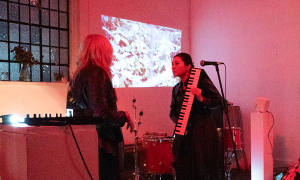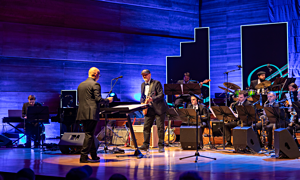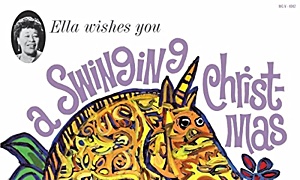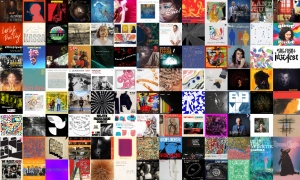Home » Jazz Articles » Live Review » Jazz Finland Festival / European Jazz Conference 2014
Jazz Finland Festival / European Jazz Conference 2014

We don’t want jazz to be run by old men. We want equality and we want women’s voices to be heard.
—Raisa Siivola (Finnish Jazz Federation)
Hotel Crowne Plaza/Various Venues
Helsinki, Finland
September 18-21, 2014
When the steamship RMS Andania docked in the port of Helsinki in 1926 it unloaded more than just cargo. The American jazz group the Andania Yankees that disembarked stayed for two months and effectively kick-started jazz in the Finnish capital. Today, Finnish jazz is in rude health and it was the mission of the Finnish Jazz Federation to showcase a broad cross-section of its finest up-and-coming jazz talent to the two hundred or so jazz professionals gathered in Helsinki for the General Assembly of the European Jazz Network, which for the first time was also open to non-member professionals.
The European Jazz Network
As the name suggests, the three-day Jazz Finland Festival was essentially a shop window aimed at the dozens of jazz festival directors, agents and journalists of the EJN who had come from every corner of Europe. Jazz professionals from Russia, Norway, Italy, Sweden, Hungary, The UK, Ireland, France, Rumania, Moravia, The Netherlands, Lithuania, Macedonia, Denmark, Estonia, Portugal, Turkey, Belgium, Iceland, Luxembourg, Poland, Slovenia, Slovakia, Croatia, Bosnia & Herzegovina, Belgium, Austria and Germany—all assembled for what was billed for the first time as the European Jazz Conference.
After the welcome and official opening by Annamaija Saarela, President of the EJN, the usual business of any General Assembly—a review of the year and significant developments, counting the pennies in the piggy bank and strategies for the year ahead—duly took place. But with jazz professionals also invited from Malaysia, Indonesia and Australia for a panel discussion entitled Beyond Europe there was a broader scope to the conference than networking or discussing the health of jazz within a purely European network.
Jazz Beyond Europe
Paul Augustin, Director of the Penang Island Jazz Festival, Agus Setiawan of Wartajazz from Indonesia and Joanne Kee, Artistic programmer for both the Sydney Improvised Music Association and the Sydney International Women's Jazz Festival and editor of Jazz Australia reminded all present that jazz has a history throughout Australasia almost as old as jazz itself. Significantly too, Australia and many Asian countries boast thriving jazz scenes (Indonesia has fifty three jazz festivals at time of writing) that represent healthy opportunities for cultural exchange and business.
Money, Magazines and Market Forces
Jazz, lest we forget or choose to ignore the fact—at our peril—is a business after all. Whilst money is unlikely the primary motivation for a young musician to pick up an instrument and tune it to a jazz frequency or for those fantastic Looney Tunes to start up jazz festivals (or jazz magazines for that matter), nothing much happens without the circulation of money. Festivals cannot run without serious capital in place, musicians struggle to tour without financial backing and CDs don't make and promote themselves.
It was a reality check to attend the European Jazz Media session, ably moderated by Cyril Moshkow—editor of Russian jazz magazine Jazz.RU—and learn of the dwindling numbers of hard-copy jazz magazines. When a top-quality magazine like Spain's Cuadernos de Jazz—founded in 1990 by Raúl Mao and María Antonia Garcí— folds as a hard copy concern in the face of the financial crisis it sends shockwaves through the international jazz media. More importantly, however, people lose their jobs.
Fourteen writers and photographers attended the session—down on previous years. Full-time professionals like Jon Newey of Jazzwise magazine fame were outnumbered by part-timers, volunteer enthusiasts and that increasingly common species—bloggers. What was encouraging, however, was the unquestioned enthusiasm for the cause and the determination to keep on bearing the standard through the battlefield. Most jazz media operates at the financial margins of the industry—a position which hardly reflects the important job that it does in promoting the musicians and their music.
Market forces, however, prevail, no matter how unpalatable that fact is for jazz professionals of all stripes. It was a slight surprise to learn therefore, that the twenty or so Finnish jazz bands that performed thirty-minute showcase concerts over the three days weren't paid. The argument, perhaps, is that with so many European festival directors in the audience, not forgetting those from Indonesia, Malaysia and Australia—as well as delegates from Japan—any musician should be happy to play for free knowing that a good performance might be the passport to performing at foreign jazz festivals. It's an argument, however, that many festivals themselves use to lure bands cheaply and one that musicians are no doubt sick of hearing.
What's In A Name?
The question of what makes a jazz festival a celebration of art was at the core of Matti Nives morning session. During an animated ninety minutes around forty attendees—mostly festival directors—shared their insights and differences of opinion on the importance of festival branding, funding and the cultural experience of festival goers.
There was clearly a division—a minor rift in fact—between those who think jazz is in robust health and those who see it as in spiraling decline. The glass half- full/half-empty viewpoint seemed to rest on the limits of the definition of jazz. It's true that if we're talking about trad jazz then we're one nail away from a sealed coffin; if, on the other hand, we're of the opinion that jazz in 2014 is less about style and more to do with an approach to music-making, then there are, as Ian Dury and the Blockheads reminded us, reasons to be cheerful: "A bit of grin and bear it, a bit of come and share it."
The crux of the problem runs deep; several jazz festival directors lamented ever having put the word jazz in the festival name due to its loaded nature and its ability to turn certain sections of society—seemingly very large ones—away from the doors. As one festival director said: "It [jazz] was the stupidest name I could ever have given my festival." The Moers Festival in Germany is one example of a festival that decided to drop the word jazz from its name. Arguably what stops many other festivals from following suit is the Arts Council funding that the very word "jazz" is often able to leverage.
Visit to Helsinki Music Centre
University is free in Finland, as Jussi Kannaste, Head of Jazz Department told a group of EJN delegates on a visit to the Helsinki Music Centre, home to the Sibelius Academy of music. The Sibelius Academy is the only music university in Finland and grew out of the Helsinki Music Institute where Jean Sibelius was a violin/composition student between 1885 -1889. The HMC is home to the Helsinki Philharmonic Orchestra and Radio Symphony Orchestra.
The construction of the Helsinki Music Centre was initially the source of much debate and the building site was considered a major eyesore in the city centre. However, the glorious edifice that arose—open, luminous and state of the art—is now a source of civic and national pride. At a cost of $160 million it was, as somebody pointed out, at least twenty million dollars cheaper than Skyfall, the last James Bond film, which apart from an exhilarating fifteen-minute opening was largely forgettable coswallop. You can see every cent of the HMC's $160 million investment in its design.
Many of the musicians performing at the Jazz Finland Festival had passed through the centre's jazz program, which began in 1983. Bachelor and Doctorate degrees are on offer and the list of visiting artists to the HMC is a who's who of modern American and European jazz. A Junior Academy offers aspiring young jazz students tuition every other weekend and in addition, the HMC runs a summer camp for jazz students aged thirteen to fourteen.
No expense has been spared at the HMC. When the Wayne Shorter Quartet came to perform in the magnificent main concert hall, pianist Danilo Pérez was offered a range of twenty Steinway pianos from which to choose. The pursuit of musical excellence is clearly the driving force behind the HMC, which as Henk van Leeuvwen of Australia Northern Europe Liaisons pointed out, is not necessarily the case with some commercial jazz programs in Australia and North America. He suggested that "increasingly commercializing courses perhaps makes the skill level at entry point less important."
Young Nordic Jazz Comets 2014
Musically, the Jazz Finland Festival was a feast, though the challenge was in digesting the quantity of music on offer. The first evening began at the downtown Koko Jazz Club, where five bands presented their wares in the Young Nordic Jazz Comets 2014. Started in 2000, the YNJC functioned as a competition until 2012, before changing to a showcase format. Over the years artists including Jazz Kamikaze, Albatrosh, Pixel and Hanna Paulsberg have all got a leg-up from the exposure afforded by the YNJC.
Five bands and five quite different musical proposals: Icelandic quartet Aurora's rhythmically elastic acoustic jazz veered between feather-light grooves, catchy group vamps of contemporary hue and headier, more intense rhyhms. The final song of its set proved it can also pen a damn fine tune; Helgi Rúnar Heiðarsson stood out as one of the more impressive saxophonists of the entire Jazz Finland Festival.
Norwegian power-trio Krokofant's eponymous debut on Rune Grammofon (2014) garnered rave reviews and its brand of andrenaline-pumping jazz channeled the prog-rock of King Crimson circa the grungy Earthbound (Island 1972) and punkish modernists such as Acoustic Ladyland or PELbO.
Citing Albert Ayler and Jesper Zeuthen as major influences, Danish trio Musik för hemlösa's music was both free and meditative, with saxophonist Signe Emmeleuth, drummer Amadeus Wedberg and bassist Björn Petersson combining in intimate dialog that visited fairly dissonant terrain—squealing sax and sawing arco—and sparsely melodic, folkloric spaces alike.
Intone, a multi-national quintet from Sweden was formed by Californian saxophonist Eric Arellano and bassist Beate Wiesinger in 2010. With four years gigging under its belt and an impressive self-titled debut album (MaRy Music, 2012), it was no surprise that the band sounded tight. Its modern, straight-ahead jazz was essentially melodic. Arellano, trumpeter Oskar Stenmark and guitarist Per Ovang all impressed as soloists but the compositional strength and coherent group identity stood out above all else.
The final band, Elena and the Rom Ensemble from Finland, a quintet led by vocalist Elena Mindru fused straight-ahead jazz with folksy elements of Mindru's Romanian heritage. Mindru's striking vocals—laced with improvisation—the band's lightly propulsive swing and Sampo Hiukkanen's singing violin were key ingredients in an engaging set that showcased the recording, Evening in Romania (EM Records, 2014).
No Country For Old Men
The youthful energy and distinctive quality of the five bands gave a glimpse into the diversity and vitality of jazz in the Nordic countries. Collaboration between the five Nordic countries through the Nordic Jazz Association has been going strong since 1999. The aims of the NJA, explained Raisa Siivola of the Finnish Jazz Federation during the main conference, are to advocate jazz, build jazz audiences, promote the music internationally and promote gender equality.
On this latter note, Siivola stated: "We don't want jazz to be run by old men. We want equality and we want women's voices to be heard." If Jazz Finland Festival is anything to go by there's still a long way to go on the equality front, as vocalists apart, female musicians numbered just four in total in the twenty plus bands that performed. Women were seemingly much better represented as agents, managers, administrators and festival directors. That in itself is undoubtedly an improvement from the male-dominated hierarchies of the past but the question still remains as to why so relatively few women make it as jazz instrumentalists. Siivola also urged festival directors to be more adventurous: "Take risks with programming. The old giants won't be there forever."
Five Heads Are Better Than One
The NJA is a good example of strength in numbers. As Siivola underlined, the five countries combined represent some twenty million people as opposed to the five and a half million of Finland alone. The NJA will make its presence felt at the jazz industry trade fare Jazz Ahead in 2015 where it hopes to promote co-produced tours, tour exchange and co-marketed festivals.
Strength in numbers is perhaps a model that could serve Asian jazz promoters well too, not to mention the Australian/Asian connection. An annual Asian/Australasian jazz festival that rotates host-country each year could work as a showcase for the abundant contemporary jazz/improvised music talent that exists beyond Europe and as a platform for exchange and collaboration—in other words a bridge-building exercise.
Finnish Jazz Showcase: Part II
The second night of showcase music was held in the Helsinki Music Centre, with five bands performing back to back thirty-minute gigs in two rooms—the intimate Black Box and the more formal Camerata—to maximize turnaround time.
AR Quartet simmered and exploded like the Wayne Shorter Quartet, though with a more compositionally minded approach to contemporary jazz. Soprano saxophonist Sampo Kasurinen's keening lines contrasted with pianist Artturi Rönkä's more fluid, classically tinged approach. Bassist Eero Seppä and powerhouse drummer Jonatan Sarikoski varied the rhythms to great effect. Rönkä dedicated the baroque-flavored "Grand X" from the band's eponymous debut (Fredriksson Music, 2014) to Kenny Wheeler who sadly, had passed away the day before. Sleek and stylish modern jazz from AR Quartet.
Over in the Camerata the Aki Rissanen Trio gave one of the standout performances of the Jazz Finland Festival, with pianist Rissanen's atmospheric compositions linked to the wall-sized animations from the movie Amorandom. The music was structurally sparse yet grooving, with bassist Antti Lötjönen's lithe ostinatos and inventive drummer Teppo Mäkynen's gently coursing pulses the perfect foil to Rissanen's less-is-more lyricism.
The Ilmiliekki Quartet's albums March of the Alpha Males (TUM Records, 2003) and Take it with Me (TUM Records, 2007) have marked it out as one of the finest young Finnish jazz groups of the last decade. With trumpeter Verneri Pohjola channeling Tomasz Stańko in an utterly commanding—though by no means reverential—performance it was easy to see why Edition Records were keen to sign him.
There was something of ECM's imprint in this powerful quartet's voice, with the music's spell residing in the tight interplay between pianist Tuomo Prättälä, drummer Olavi Louhivuori bassist Antti Lötjönen and the singularly impressive Pohjola. An intense slower number, "Lonely Lonely" rounded out a mesmerizing set. A quartet to rival Stanko's.
Back in the Camerata, pianist Kari Ikonens' trio opened with "Pacific" from the acclaimed Bright (Ozella Music, 2013), before playing a couple of new tunes from the forthcoming release. The first bore the imprint of bassist Ara Yaralyan's Armenian heritage; with Markku Ounaskari switching between softly rumbling mallets and brushes, Yaralyan's yearning arco narrated this gentle love song while Ikonen accompanied sympathetically. 'To The East" was inspired by a Bollywood movie and unsurprisingly was strong on melodic hooks and rhythmic impulse.
The final gig in the Helsinki Music Centre was a quartet led by singer Nina Mya. Pori Jazz Artist of the Year 2012, Mya was a throwback to the golden days when female jazz vocalists ruled the roost. With pianist Henri Mäntylä, bassist Jori Huhtala and drummer Tuomas Timonen swinging hard, Mya impressed on her own composition "Illusion"—with an extended traditional scat—and on Herbie Hancock's "Butterfly." Awash with instrumental music as the evening had been it was refreshing to finish on Mya's sung note.
An Audience With Siggi Loch, ACT Records
A highlight of the three days for many was the interview—back in the conference centre—with ACT Record's Siggi Loch, conducted by Matti Nives. Loch spoke of the impact of his first ever jazz concert when just fifteen—the inimitable Sydney Bechet: "It hit me like thunder," recalled Loch. "I instantly became a fan, not knowing what this music was about."
In an engaging talk, Loch spoke openly about his early career with EMI, selling records from a Volkswagen, his move to Phillips, WEA Music and his eventual setting up in 1992 of ACT Records, home to many of Europe's brightest jazz stars, including the legendary Swedish group the Esbjorn Svensson Trio.
After more than 300 releases on ACT Records Loch clearly still has huge passion for music and for the business of putting out the music he loves. As he told the audience, there's no sign of him calling it a day any time soon: "My dream is to bop 'til I drop."
Loch was present at all the showcase gigs, bopping away, and that must have been some consolation for many of the musicians who were unhappy about not being paid. For Loch, as he said during the interview, is spontaneous by nature. If he sees or hears something he really likes he's quite likely to sign the band up.
Finnish Jazz Showcase: Part III
The final evening's music took place in the Culture Factory Korjaamo, a former tram warehouse converted into a vibrant arts centre. Nine bands of very different stripes played half-hour sets one after the other on two different stages. With so many bands on a conveyor belt the acid test was which ones stood out in the memory the following day.
In truth, every band had something unique about it. Elektro GT's brand of jazz found space for electronics and rock. Trumpeter Jorma Kalevi Louhivuori's blistering attack, guitarist Timo Kämäräinen's gnarly rock idiom and Aki Rissanen's pop-art keyboard work made for an eclectic, exotic blend. A slower funk number sounded like the Mahavishnu Orchestra's "Thousand Island Park" and solos were appropriately extended and exuberant.
The Umo Jazz Orchestra—the only professional jazz orchestra in Finland—gave a mightily swinging performance of Ellingtonian elegance, laced with the blues and tangoish verve. Free-jazz was the order of the day with saxophonist Mikko Innanen & Innkvisitio, where the leader was joined by Liudas Mockunas' clarinet in screeching disharmony. Baritone and tenor likewise doubled up in heady dialog over Joonas Riippa's blistering drumming.
A few familiar faces turned up in Sun Trio: trumpeter Jorma Kalevi Louhivuori, drummer Olavi Louhivuori and the ubiquitous bassist Antti Lötjönen were not long off the back of a US tour to promote their third CD, In The Dreamworld (CAM Jazz, 2014) and gave a flaming acoustic jazz performance, tempered by a haunting version of Rufus Wainwright's "Zebulon." This trio goes from strength to strength.
The late cancelation of guitarist Teemu Viinikainen's trio meant an unexpected slot for indie-pop band Elefantree. Charismatic singer Anni Elif Egecriolu—who dabbled on keyboards and glockenspiel—drummer Olavi Luhivuori(again) and tenor saxophonist Pauli Lyytinen occupied a space between somewhat angular pop compositions of arresting lyricism and energetic collective improvisation.
One of the most straight-ahead sessions was served up by Jussi Fredriksson Jazz Wars. The sextet showcased a segment of The Jazz Wars (Fredrikkson Music, 2012). Pianist Fredriksson's concept album addresses themes of power and warfare and the music was correspondingly taut and febrile. Keyboardist Fredriksson, saxophonist Joonatan Rautio, trumpeter Jukka Eskola, bassist Ville Herrala, drummer Jussi Lehtonen and guitarist Marzi Nyman—who brought a John Scofield- esque bite—gave a lively performance that terminated a little too soon.
Raul Björkenheim's eCsTaSy quartet's intense set, based on material from its debut recording, eCsTaSy (Cuneiform Records, 2014), served up free jazz driven by guitarist Björkenheim and saxophonist Pauli Lyytinen's energetic—at times ecstatic— exchanges and fired by the polyrhythms of drummer Markku Oumasaki. Free jazz it may have been but Bjorkenheim's compositions, even at their loosest, were both emotive and melodic at core.
The Timo Lassy Band presented one of the more soulful, groove-based shows. It's brew of soul-jazz, danceable Afro-Caribean rhythms—courtesy of the impressive drummer Teppo Mäkynen's and percussionist Abidissa Assefa—and Lassy's saxophone-led melodic hooks recalled the driving, good-time vibes of the New Cool Collective. With people in the mood to let off steam dancing duly broke out -an element all too often missing from jazz festivals. That man Lötjönen was once again on bass, which either meant he's keeping other bassists out of work or there are no other jazz bassists in Finland.
There was just time to catch the tail end of Dalindèo's show on the second stage. Having recently won the Jazz Album of the Year 2013 for Kallio at the Finnish Emma-gala, the sextet is riding the crest of wave. Guitarist/founder Valtteri Pöyhönen's stylish retro jazz evoked a cross between a Quentin Tarantino soundtrack as played by Tom Waits. Rasmus Pailos' percolating percussion, the close-knit saxophone and trumpet motifs of Pope Puolitaival and Jose Mäenpää, Poyhonen's Marc Ribot-ish guitar twang and the in-the-pocket rhythms of bassist Pekka Lehti and drummer Jaska Lukkarinen animated the crowd and drew a line under what was an avalanche of good music over three fun-filled days.
Wrap Up
If the Finnish Jazz Federation's aim in staging the Jazz Finland Festival was to raise the international profile of Finnish jazz in all its wonderful diversity then the Jazz Finland Festival was an undoubted success. Multiple European jazz media sources covered the events while the real movers and shakers of European jazz were introduced to a kaleidoscopic spectrum of Finnish jazz. Most of the delegates went home with suitcases bulging with CDs and carrying memories of great music and warm hospitality.
Further success of the JFF will be measured in subsequent touring and performance opportunities abroad for the participating musicians of the JFF and any increase in the international media profile of Finnish jazz in general. As for the European Jazz Network, the future also looks bright. With funding secured as part of a three- year project, plans are afoot for an extensive written history of European jazz.
There's even a little budget set aside for exploring jazz beyond Europe in a program of trans-national cooperation. What that means exactly wasn't revealed but with luck we may yet see a few more Asian or Australian bands in European jazz festivals in 2015.
Hopefully the Jazz Finland Festival will become a regular occurrence—certainly there seems to be a wealth of young, rising jazz talent in this country of just five and a half million that warrants regular showcasing. The next European Jazz Conference will be held in Budapest in September 2015. No doubt everyone will look forward to meeting up with the Finnish delegates once more, who were wonderfully cordial and generous hosts at Jazz Finland Festival 2014.
Photo Credit: Courtesy of Maarit Kytöharju
Tags
Verneri Pohjola
Live Reviews
Ian Patterson
Finland
Helsinki
Wayne Shorter
Danilo Perez
Jazz Kamikaze
Albatrosh
Pixel
hanna paulsberg
King Crimson
Acoustic Ladyland
Albert Ayler
Jesper Zeuthen
Kenny Wheeler
tomasz stanko
Kari Ikonen
Herbie Hancock
Esbjorn Svensson
Mahavishnu Orchestra
Tom Waits
Marc Ribot
Budapest
PREVIOUS / NEXT
Support All About Jazz
 All About Jazz has been a pillar of jazz since 1995, championing it as an art form and, more importantly, supporting the musicians who make it. Our enduring commitment has made "AAJ" one of the most culturally important websites of its kind, read by hundreds of thousands of fans, musicians and industry figures every month.
All About Jazz has been a pillar of jazz since 1995, championing it as an art form and, more importantly, supporting the musicians who make it. Our enduring commitment has made "AAJ" one of the most culturally important websites of its kind, read by hundreds of thousands of fans, musicians and industry figures every month.



